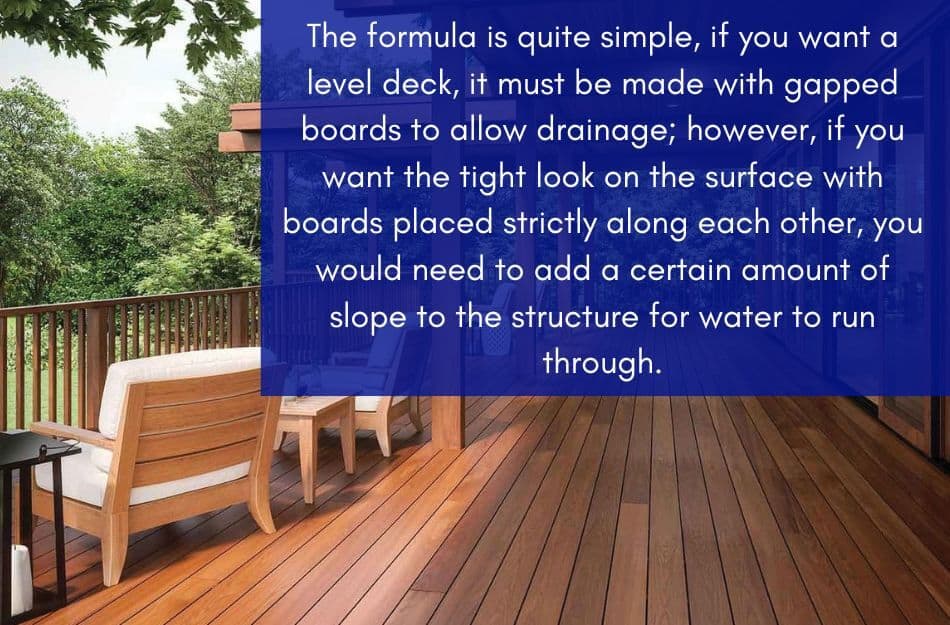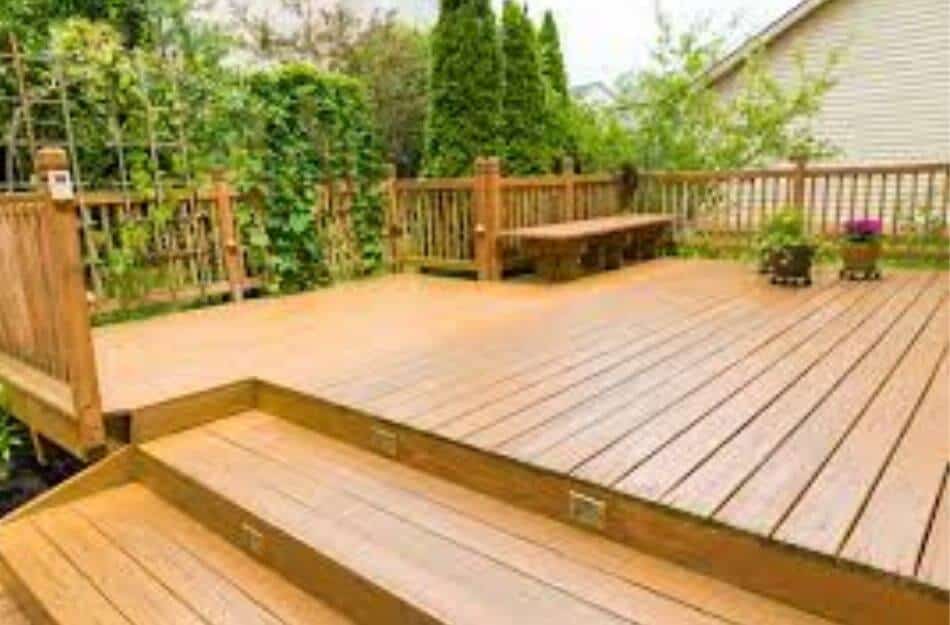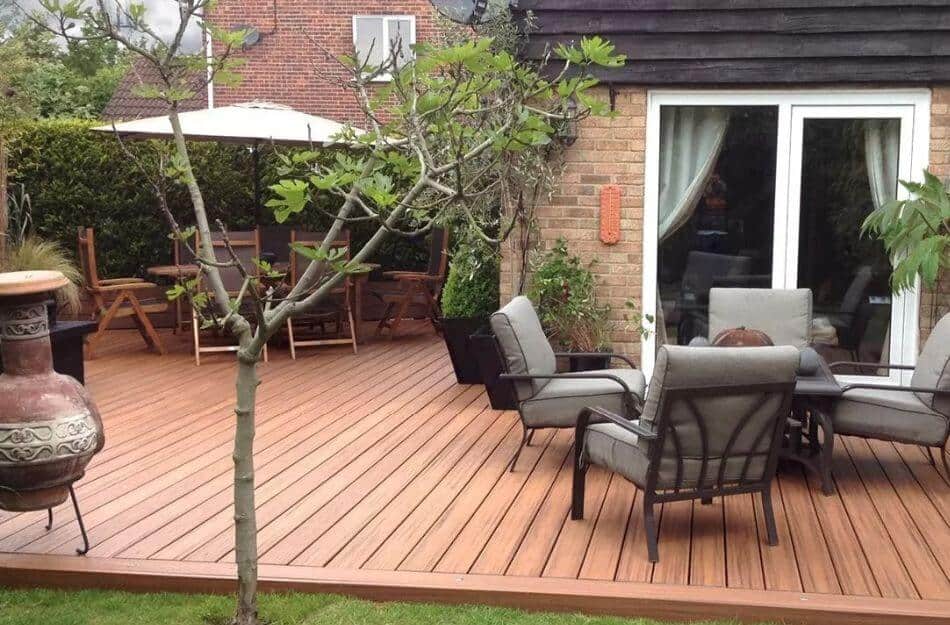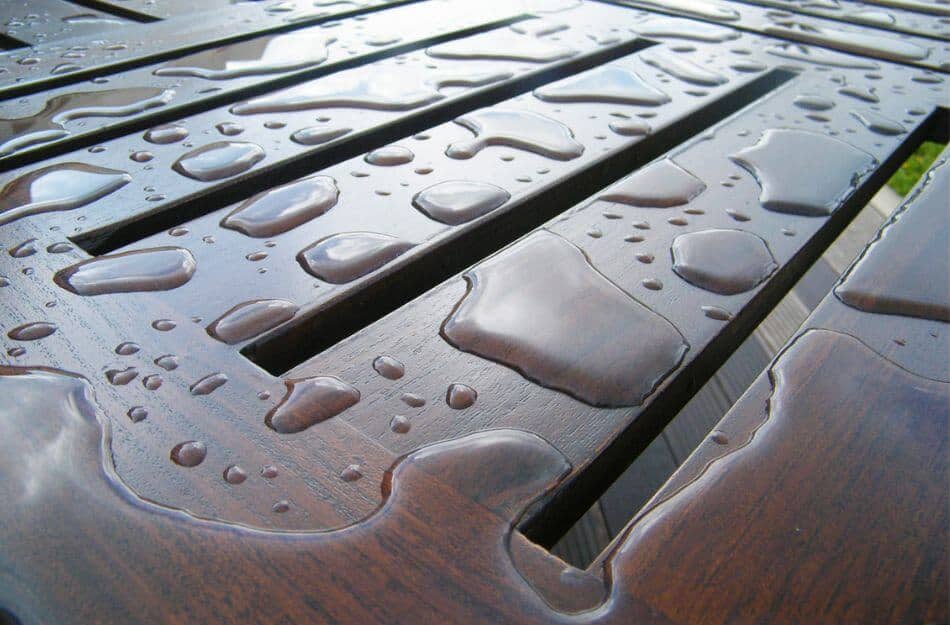Building a deck is quite a simple task but deciding whether to keep it leveled or sloped can be a tricky question. House owners looking forward to building a deck often find it confusing why they should build a deck sloped and what’s the difference between sloped and leveled decks?
The formula is quite simple, if you want a level deck, it must be made with gapped boards to allow drainage; however, if you want the tight look on the surface with boards placed strictly along each other, you would need to add a certain amount of slope to the structure for water to run through.

Table of Contents
Level Vs. Slope | What To Choose & When
Rain and snow are significant factors you need to consider before you build your deck. How much of these you receive depends on your area and the time of year.
However, it can’t be ignored, as rain plays a major role while making structural decisions for your deck.
If your area receives high rainfall or snowfall, you need to choose between a sloped deck or a level deck with a drainage system to let the water off.
However, many people do not know the difference between both and often get confused as to what they should choose and why.
Below, both of these have been explained in-depth so you can make your decision accordingly.
Also Read: Can You Install Trex Decking In The Winter?
Sloped Deck
A sloped deck does not mean that your deck will look like the bottom of a cliff or the slide in the waterpark. The slope has to be minimal and just enough to allow the water to trickle off of the surfaces.
The purpose of a slope is to allow water to slip off the deck in times of rain, so you don’t have a mini pool or puddle in the center of your deck.
Not only will the rainwater make it impossible for you to use the deck once cleaned, but it will also destroy the deck as it can seep into the wooden boards and cause them to crack or chip off.
In addition, if your wood is not treated for moisture-repellent properties, you’re standing at an even larger risk of getting your deck destroyed in rain. The water can cause irreversible damage to your deck which can ruin all your money and your efforts on the project.

Besides, the rainwater can also damage your furniture on the deck if it is allowed to stay for long.
To avoid this problem, you need to get a slope in your deck, and we’re talking about something other than the kind of slope you see when going downhill.
A minor slope ranging from an eighth of an inch to a quarter inch per foot of the length is good enough to let water slide down.
Make sure the slope is directed away from the house, so you don’t have to deal with all the rainwater pouring right into your doorstep.
Such a slope is not visible to the naked eye, but it is ample to prevent the water from getting stored on the surface.
It gives the water an angle to flow on and as the pressure builds and more raindrops fall, the water slowly starts to go downstream.
Once it reaches the edge or any space between the planks, it starts to trickle off, clearing the surface of your deck.
You May Also Like: Can Deck Screws Be Used For Framing: An Insight
Level Deck
To build a level deck, you need to provide a drainage system from which the water can fall and doesn’t get stored on the surface. You’re going to do that by leaving gaps between the boards.
Leaving just the right gap between the boards will create an easy pathway where the water can flow freely and trickle down. You would be thinking right now about the structure’s strength and the base’s sturdiness.
The gaps are not big enough to be noticed; they are micro-adjustments in the placements of the planks which allow water to run off of the surface.

So worry not, as the gaps are minimal and noticeable until you focus on them. Besides, the strength of your deck is based on the joist base you built on the bottom and not the strength of the boards alone.
You might wonder how the drainage system works, so allow us to explain. By leaving a gap of around 3 to 8mm on the end and sides of the board (respectively), you create a narrow and constricted channel for water.
Remember that this measurement is approximate and might vary according to the type of wood you used and the size of your deck.
You can consult the packaging on wooden planks, the user manual, or the manufacturer to get the exact details of the amount of spacing you require for your decking project.
Moving on, as rain falls on the boards, the water can’t stay on the board itself due to the momentum it holds from falling.
Hence, it has to move in a certain direction, and as it moves, the droplets will fall into the narrow channel that you’ve created.
Slowly, the quantity of water increases as the rain continues to pour, but the space of that channel remains the same. This creates pressure and forces the water to move along the channel.
It keeps on moving until the channel ends, and the water trickles down; in this way, your drainage system easily prevents water from staying on deck and ruining your wooden surface.
See Also: How To Lay Decking On Grass? Definitive Guide
Which One Is Better?
If you are on a budget or do not know the technicalities much; then you must opt for a level deck with a drainage system as it is easier to build and less complex.
However, if you’re going to hire professionals or have experience yourself, you can go for a sloped deck as it will be much more suitable for you.
Both techniques work quite efficiently, and it would be unfair to proclaim one superior. Hence, it depends on your requirements and preferences, and the decision falls upon you to decide which one suits you the best.
But make sure that whatever you choose, you must have a drainage system under the deck or on the side as well.
This is because when the waterfalls, it might puddle on the ground and add more moisture and humidity to the soil which can in turn be an even greater nuisance for you.
Why Is It Important To Let The Water Off The Deck?
If you let the water stay on the deck, it will ruin your furniture and deck, as we discussed before. However, there is another major reason why you need to build a drainage system.
The water can’t stand on the deck forever; it will either seep into it or evaporate into the air. However, you might need to level the ground before building your deck, and a slope is directed towards the house.
If your deck is connected to your house directly, you will face the issue in another scenario. The issue is that the rainwater might start moving towards your house.
Now as little as the problem sounds, the magnitude is way higher than you might think. Keep on reading, and you’ll find out why.

Suppose you have 1/4″ (6mm) of rain in your area on an average rainy day. This might sound reasonable and will surely pose no threat to the walls or foundations of your house.
But if you have a deck measuring 12′ (3.6m) x 12′ (3.6m), gathering that water, the minimal 6mm rainwater turns into 75 liters of water rushing into your house.
Not only will it affect the walls and foundations, but you can also face serious issues with rooms and toilets located below the level of the doorway.
If you have a basement, the problem would be intensified by a factor of 10.
Even if you keep these factors aside, you would still need to constantly wipe the water off your doorstep and your deck which is something you surely don’t want on a Saturday night when you’re looking forward to enjoying a football match.
Besides, a bigger deck would only mean that the water has increased and so has the problem.
Hence, it is very important to ensure that water doesn’t get stored on top of your deck, and if it does, there is a drainage or slope system to get it away from the deck and the house immediately.
Remember that any slope, below or above the ground, should be pointing away from the house under any circumstances. As again, you don’t want the water to puddle on your doorstep or entrance.
Clean The Deck Regularly
Once you have built the deck with the proper drainage system or with the slope at the right angle, clean it and dry it if necessary.
The reason behind this is that in drainage systems, the water will not be stored above the boards, but it can still get trapped in the gap between the boards.
If not removed timely, this can again seep into your boards and, even worse, into the joist’s structure and cause damage.
Although it does not pose as much threat, leave it uncared for a long time, and the consequences will start to appear.
Moreover, the slope can ward off the water majorly, but there would still be some droplets stuck on the edges, and overall humidity remains in all circumstances.
If there is any dirt or grime at this point, the humidity can lead to molds in the grime which can, in turn, give birth to infestations.
Furthermore, not cleaning timely can mean that the dirt is going deeper into your wood grains, causing them to become weaker over time and lose their strength and color.
Seal The Deck On Time
Once you have built the deck and considered all the necessary factors we discussed, seal your deck with a clear wood sealant as soon as possible.
Doing so can minimize the chances of water penetration into the boards. Moreover, it can reduce the risks of color fading through UV exposure and help sustain the shine and lush appearance of your deck.
Sealing your deck also has many other benefits, such as building a layer between your actual deck surface and all the dust and grime that may build up.
Furthermore, it prevents the boards from getting too dry in winter and too moist in humid conditions.
Hence, it is important to seal the boards on time to increase their longevity and promote their health.
Final Thoughts
You should not let water stay on your deck under any circumstances as it is not going to yield any benefits and will only bring damage to your wooden planks.
Sloped decks, and level decks are both great options and whichever one you choose depends on how you want your deck to look, and what’s easier or more affordable for you to build.
The main purpose here is to allow drainage for rainwater, so follow the steps above and build the deck you like the best!
Recent Posts
Although deck sealing may not be at the top of your summer to-do list, you shouldn’t put off a task.One such deck that channels the opposite of the lively and enjoyable vibe you want from an...
Any home would benefit from having a deck because it adds more area for socializing, relaxing, and outside activities.Garden decking that has been properly polished can be elegant and lovely. It...
